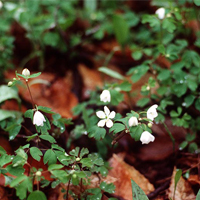Eastern False Rue-anemone
Scientific name: Enemion biternatum

Cover photo credit: Michael Oldham
Status
Special concern
Special concern
means the species lives in the wild in Ontario, is not endangered or threatened, but may become threatened or endangered due to a combination of biological characteristics and identified threats.
Date added to the Species at Risk in Ontario list
June 30, 2008
On January 26, 2022, the common name of this species was updated on the Species at Risk in Ontario List from False Rue-anemone to Eastern False Rue-anemone to be consistent with recent nomenclatural changes.
This name change does not change the protections afforded to the species under the Endangered Species Act, 2007 or the applicability of any policies, permits and agreements, guidance documents – including recovery guidance — or best management practices that may have been published or issued by the Government of Ontario in respect of the species.
Read the most recent assessment report [PDF]
What it looks like
Eastern False Rue-anemone is a member of the buttercup family. It grows to a height of 10 to 40 centimetres. Most leaves are divided into three groups of three leaflets, each leaflet being irregularly two to three lobed.
The flowers, which bloom in early spring, occur singly or in groups of two to four.
They are small and delicate with five showy white petal-like sepals (modified leaves or bracts that look like petals). The fruit is produced in early June and contains many smooth seeds.
Where it lives
Eastern False Rue-anemone grows in deciduous forests and thickets with rich, moist soil, often in valleys, floodplains and ravine bottoms.
This species is frequently found close to watercourses within mature forests with lots of maple and beech trees.
It prefers partial sun or somewhat shady conditions.
Within Canada, Eastern False Rue-anemone is only found in Ontario. In the United States, Eastern False Rue-anemone is found along the eastern portion of the country, with records in 24 states.
Where it’s been found in Ontario
Eastern False Rue-anemone is only found in southwestern Ontario surrounding the City of London. Observations of the species occur in a narrow band of this area extending from Port Stanley to Port Franks.
Individuals of this species have also been documented in the Simcoe area.
What threatens it
The main threat to Eastern False Rue-anemone is habitat destruction due to recreational activities such as cycling, ATV-use and hiking, which can result in inadvertent trampling of this plant.
Forest clearing, soil erosion, and agricultural run-off are also concerns. Road salt is known to have harmed at least one population in Ontario.
Invasive plants that compete with Eastern False Rue-anemone for water, light, and space, such as Goutweed (Aegopodium podagraria) and Garlic Mustard (Alliaria petiolata), also threaten this species.
Action we are taking
While special concern species and their habitat do not receive protection under the Endangered Species Act, 2007, the act requires the preparation of recovery guidance for special concern species, unless a recovery strategy or management plan is required for the species under the federal Species at Risk Act.
All species listed on the Species at Risk in Ontario List may be eligible for consideration for government funding through the Species at Risk Stewardship Program.
Recovery strategy
A recovery strategy advises the ministry on ways to ensure healthy numbers of the species return to Ontario.
Read the executive summary and the full document (December 7, 2018).
Government response statement
A government response statement outlines the actions the government intends to take or support to help recover the species.
Read the government response statement (September 5, 2019).
Review of progress
A review of progress made toward protecting and recovering a species is required no later than the time specified in the species’ government response statement, or not later than five years after the government response statement is published if no time is specified.
Read the report on progress towards the protection and recovery of 12 species at risk, including Eastern False Rue-anemone (2024).
What you can do
Report a sighting
Submit your observations of species at risk to the Natural Heritage Information Centre (NHIC), which is Ontario’s conservation data centre. Join the "(NHIC) Rare Species of Ontario" project in iNaturalist to make submitting your observations quick and easy.
Volunteer
Volunteer with your local nature club or provincial park to participate in surveys or stewardship work focused on species at risk.
Be a good steward
Private landowners have a very important role to play in species recovery. If you find Eastern False Rue-anemone on your land, you may be eligible for stewardship programs that support the protection and recovery of species at risk and their habitats. Learn more about the Species at Risk Stewardship Program.
Invasive species seriously threaten many of Ontario’s species at risk. Learn more about invasive species in Ontario and how you can help. As with all wildlife, be respectful and observe from a distance.
Report illegal activity
Report any illegal activity related to species at risk to
Quick facts
- The scientific name for Eastern False Rue-anemone, Enemion biternatum, is thought to refer to the Greek word anemos, which means wind, and the Latin word biternatum which means twice in sets of three (referring to the leaves and their division into leaflets).
- Unlike other flowering plants, Eastern False Rue-anemone does not produce nectar to attract insects to pollinate its flowers. However, because it is one of the first plants to produce flowers in the spring, it can attract insects that don’t yet have tastier options.